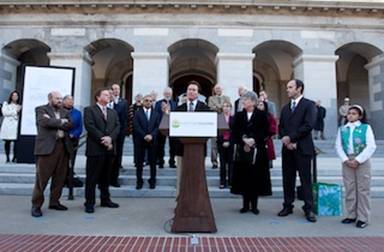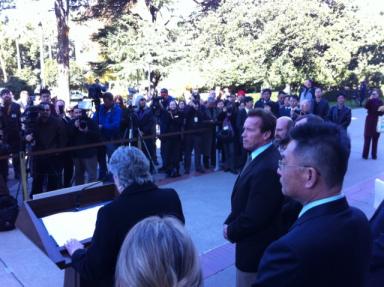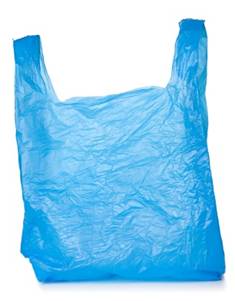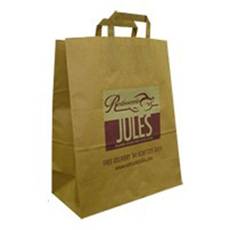|
|
Representing Richmond, I participated in a press conference yesterday on the Capitol steps as part of a Statewide Coalitions Join Forces to Support Local and Statewide Bag Ban Efforts. The event was co-hosted by Green Cities California (GCC) and the Clean Seas Coalition (CSC) to highlight fast moving local and statewide efforts to restrict the use of single-use bags. The news conference was headlined by Assemblywoman Julia Brownley. AB 1998 (Brownley) would have provided uniform statewide restriction of single use bags, but failed passage in August. Local governments are adopting their own bans; LA County adopted their bag ban ordinance on November 16, and San Jose, Marin County, Santa Monica, Santa Clara County and many other jurisdictions plan to follow suit soon. The press event will promote local action and urge the Legislature to continue to work toward green job growth and a safer environment by adopting statewide policy that promotes reusable bags.
Governor Schwarzenegger spoke in favor as did Massood Eftekhari, L.A. County Public Works Director, Kansen Chu, San Jose City Council, Barry Broad, Food & Commercial Workers Union, Andy Keller, Chico Bag, Suja Lowenthal, Long Beach City Council and Ross Mirkarimi, San Francisco Board of Supervisors.
If AB 1998 is not revived and passed in the next couple of months, I expect Richmond to join many other cities and counties in California passing an ordinance restricting single use bags


SACRAMENTO, CA - Gov. Arnold Schwarzenegger wants state lawmakers to resurrect a plastic bag ban bill that died on the Senate floor over the summer.
The bill would have banned single use plastic bags in grocery stores, but it failed to pass. The governor said he wants lawmakers to try, try, and try again, even encouraging them to bring the bill back during the special budget session that starts on Dec. 6.
Since the original California plastic bag ban bill died, several cities throughout the state have adopted similar ordinances in an effort to rid their city of plastic bag waste. Los Angeles County was the first to adopt such an ordinance. Since then, San Francisco, Malibu, Palo Alto and several others have followed.
However, Schwarzenegger said the local efforts to ban the bags are not enough.
"I think what the locals are doing is a terrific effort, but my preference is to do a statewide ban on plastic bags. That's the bottom line," the governor said.
The American Chemistry Council was the bag ban bill's biggest opponent last year. They said if lawmakers introduce new legislation banning plastic bags, they'll continue to fight against it.
"I think when you look at $20 billion in the hole, the state might have bigger priorities than trying to address plastic bags and putting more people out of work," said Tim Shestek with the American Chemistry Council. "If that is the message the governor wants to send, that would be unfortunate for those working families around, up and down the state."
News10/KXTV
CLEAN SEAS COALITION AND GREEN CITIES CALIFORNIA
BAG BAN PRESS EVENT - NOV. 29TH, 2010
THE TRUE COST OF SINGLE USE BAGS FACT SHEET
For recently developed facts developed for the LA County ban, see Heal the Bay’s excellent summary here: http://www.healthebay.org/get-involved/take-action/rally-county-ban-bag#FAQsBagBan
- Californians use more than 19 billion plastic grocery bags each year
- Use of single use bags generates 147,038 tons of unnecessary waste each year
- Californians throw away over 600 plastic bags per second.
- California taxpayers spend millions annually to dispose of plastic bag waste.
- U.S. consumers use 100 billion plastic bags annually - all made from fossil fuels.
- Cities are already moving to ban bags - in CA, the U.S, and around the world.
- Bag bans save taxpayers money; the costs of plastic bags are enormous. (See True Cost of Single Use Bag fact sheet below).
- Currently, most of these bags end up in landfills and many are littered and make their way into the environment where they end up in the food chain.
- A unique group of stakeholders supports banning bags: environmental groups, local gov’t, labor, etc. Opposition, like Prop 23, is from out-of-state oil companies and the American Chemistry industry.
- Bag bans will create opportunities for green jobs in CA. Moreover, most manufacturing facilities in California make dozens of different products – not just plastic bags; they will not have to close their doors.
- Recycling is not the answer. Only 1-5% of plastic grocery bags get recycled. And this recycling is only down-cycling. Plastic grocery bags still require virgin resin (majority or all of their content), and that resin comes from oil, a non-renewable and dangerous resource.
- We can do this. And other local governments have shown that restricting plastic bag use can make a difference.
JOBS AND ECONOMIC TALKING POINTS IN SUPPORT OF BAG BANS
Bag Bans will help underserved communities
- Major reusable bags companies have found that sales of reusable bags is higher in lower income areas where people need to walk to and from their store, than in more affluent areas. These consumers are already choosing reusable bags.
- These same lower income people are the most affected by the inland urban blight caused by blow-away single use bags.
- California taxpayers pay millions of dollars every year to clean up this trash.
- Right now, when people buy food, the cost of bags is embedded in the price of food. We pay about 2-5 cents for plastic and 5- 23 cents for paper bags. Based upon average bag usage, the City of San Francisco Dept. of Environmental estimates this amounts to about $18-30 per a year per a person.
- We then pay about 17 cents per a bag to clean it up, amounting to millions for cities!! This is money that should be going to vital citizen services (and jobs) instead.
- Some of the poorest countries on earth have citizens who shop without single use plastic bags: all of China, parts of Africa (the bags caused inland blight, and clogged water pumps), part of Australia, Mexico City, parts of India, ETC. -- 25% of the world's population lives in a place where there are no single use bags.
- Before 1982, when Safeway and Kroegers started the trend towards single use bags, families used reusables.
- There is a WIC provision in the model ordinance now for free bags, and it may be extended to food stamp recipients as well.
- There is also a gradual ramp up to give people time to save bags.
- WalMart, which services a lower-income demographic, is beginning to stop using paper and plastic single-use bags, so market forces will prevail, and the industry will provide free bags to some extent.
 The True Cost of Single-Use Bags The True Cost of Single-Use Bags
The Guinness Book of World Records has named the plastic bag the most ubiquitous consumer product of 2009 as it is produced on a worldwide scale by the trillions.[i] But what is the real cost of this throw-away consumer item? There is an external cost to provide free bags, not just to the environment, but also to taxpayers and businesses. The best solution is to decrease these external costs by avoiding disposable bags in the first place. Policy approaches, including bans and pollution fees, have proven effective tools to achieve source reduction and positively change consumer behavior.
Plastic Pollution Devalues Our Economy and Threatens Jobs
- Plastic litters our beaches, exacts a toll on our environment, and costs cities money to clean up. In fact, plastic pollution alone is costing developing and industrialized nations up to $1.3 billion annually as it threatens the fishing, shipping and tourism industries.[ii]
- Plastic pollution threatens California’s ocean economy, valued at $43 billion. An estimated 408,000 jobs mostly in the tourism and recreation sectors are tied to the Ocean economy.[iii]
- The total cost of litter collection, disposal and enforcement in the U.S. is estimated to be at least $11.5 billion annually. Businesses bear the burden of this cost, spending $9.1 billion annually and representing 79.5% of the total cost of litter abatement.[iv]
Taxpayers Subsidize Cleanup and Litter Abatement of Single-Use Bags
- Over 123,000 tons of plastic grocery and merchandise bags comprise the California waste stream.[1] This is equivalent to 16 billion plastic bags.[2] Cities have estimated that the taxpayer cost to subsidize the recycling, collection, and disposal of plastic and paper bags amounts to as much as 17 cents per bag.[v] Each year, San Francisco estimates it spends $8.5 million in plastic bag clean up.[vi]
- LA County Public Works and Flood Control District reported spending $18 million in litter collection for stormwater pollution prevention and flood control channel cleanup.[vii] Litter characterization reports plastic bags make up some 25% of litter stream.[viii] In 1994, the County of Los Angeles spent $4 million alone to clean up 31 miles of trashed coastline.[ix]
- States, cities, and counties together spend $1.3 billion on general litter abatement.[x] These are taxpayer dollars out of your pocket to subsidize the cost of waste. Much of this money could otherwise be redirected to pay for much needed public services such as parks, libraries, and public safety.
Business and Consumers Pay for ‘Free’ Plastic Bags
- Retailers spend hundreds of millions of dollars annually to provide single-use bags to customers. For example, supermarkets can spend up to $1,500 to $6,000 a month just to provide single-use bags to their customers at the check-out.[xi] Even major retailers such as Target and CVS are realizing this significant cost burden and are offering discount incentives to customers who bring their own bags.[xii]
- Stores typically pay 2 to 5 cents per plastic bag; these costs are embedded in food prices which are then passed onto consumers.[xiii]
Paper Bags – Not Much Better for the Environment or Your Wallet

Paper bags are not a good alternative to plastic single-use bags because like disposable plastic bags they come with their own costs to the environment. Although some paper bags contain no old-growth fiber, contain some post-consumer recycled content and are recyclable, the production of most paper bags contributes to deforestation, greenhouse gas emissions, and additional waterborne wastes.[xiv]
Businesses and Consumers Pay for ‘Free’ Paper Bags
Stores typically pay more for paper bags than plastic, anywhere from 5 to 23 cents per bag; these costs are then embedded in the food prices which are eventually passed on to consumers.[xv]
The Solution: Paper or Plastic? NEITHER. Choose to REUSE
The key is getting consumers to avoid using disposable plastic and paper bags in the first place. One reusable bag can replace 600 or more paper and plastic bags over its lifetime.
Several countries and cities worldwide have committed to addressing the single-use bag pollution problem. For example, Bangladesh, Belgium, China, Denmark, Germany, Hong Kong, Ireland, Kenya, Mexico City, Netherlands, New Delhi, India, South Africa, and Taiwan all have imposed fees, taxes, bans, or a combination to encourage consumers to switch to reusable bags, a more sustainable alternative. Collectively, these countries represent an estimated 25% of the world’s population that has committed to reducing single-use plastic bags.[xvi]
[1] California Integrated Waste Management Board 2008 Waste Characterization Study <http://www.calrecycle.ca.gov/Publications/General/2009023.pdf>
[ii] McIlgorm, A., Campbell H. F. & Rule M. J. (2008). “Understanding the Economic Benefits and Costs of Controlling Marine Debris in the APEC region (MRC 02/2007). A report to the Asia-Pacific Economic Cooperation Marine Resource Conservation Working Group by the National Marine Science Centre (Univ. of New England & Southern Cross Univ), Coffs Harbour, NSW, Australia, Dec 2008.
[iii] Kidlow, J. et al. (July 2005). “California’s Ocean Economy,” report to the California Resources Agency, prepared by the National Ocean Economics Program.
[iv] National Visible Litter Survey and Litter Cost Study (2009). Prepared for Keep America Beautiful, Inc. by Mid- Atlantic Solid Waste Consultants. New Market, MD, Sept. 18, 2009.
[vi] City of San Francisco Department of the Environment, “Bag Cost Analysis,” November 18, 2004.
[vii] Los Angeles County Flood Control District taken from the LA County Paper Plastic Bag Report: Cost Impact
[viii] City of Los Angeles Catch Basin Cleaning (June 10, 2004) taken from LA County Paper Plastic Bag Report: Cost impact
[ix] Los Angeles River Trash TMDL, approved by the Los Angeles Regional Water Quality Control Board, Aug. 9, 2007.
[x] National Visible Litter Survey and Litter Cost Study (2009). Prepared for Keep America Beautiful, Inc. by Mid- Atlantic Solid Waste Consultants. New Market, MD, Sept. 18, 2009.
[xi] Downing, J. “Free Grocery Bags Targeted for Extinction in California,” Sacramento Bee, Aug. 25, 2008. Estimates from bag manufacturers and the Food Marketing Institute.
[xii] Horovitz, B. “Target, CVS Put Plastic Bags in the Bull's-Eye, Pay for Reusables,” USA Today, Oct. 19, 2009.
[xiii] Los Angeles County (Aug. 2007). “An Overview of Carryout Bags in Los Angeles County: Staff Report to the Board of Supervisors,” Table 9. Based on assumption that average person uses about 600 plastic bags per year.
[xiv]Australian Department of the Environment and Heritage Plastic Shopping Bags – Analysis of Levies and Environmental Impacts Final Report, prepared by Nolan-ITU, December 2002, Page 33; U.S. Energy Information Administration, U.S. Department of Energy, “Energy-Related Carbon Emissions in the Paper Industry, 1994,” (Retrieved 12/31/08); U.S. EPA Toxic Release Inventory 2006 data for Paper Industry-NAICS code 322. (Retrieved 12/31/08).
[xv]Los Angeles County (Aug. 2007). “An Overview of Carryout Bags in Los Angeles County: Staff Report to the Board of Supervisors,” Table 9. Based on assumption that average person uses about 600 plastic bags per year.
|


 The True Cost of Single-Use Bags
The True Cost of Single-Use Bags